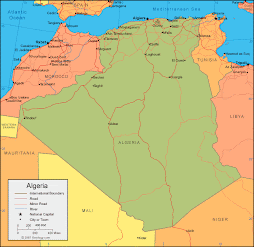Algeria Travel Guide

1st Edition / August 2007
ISBN: 9781741790993
256 pp / 8 pp colour / 30 maps
Anthony Ham , Anthony Sattin , Nana Luckham
Algeria is the most fascinating country you never thought of visiting. This North African destination has two primary drawcards: outstanding Roman ruins and the exceptional landscapes of the Sahara. So tie your turban like a Tuareg and get ready to rock the Casbah.
- Only English-language guidebook to Algiers
- Guide to the best Roman ruins in Africa
- Special chapter on travelling deep into the Sahara
- The best of Algiers' accommodation options
Algeria is the most fascinating country you never thought of visiting.
Off limits for decades, Algeria is again struggling to its feet, resilient and ready to show you just why the country is becoming many travelers favourite North African destination. Like all countries along the southern Mediterranean rim, Algeria has two primary drawcards: outstanding Roman ruins and the exceptional landscapes of the Sahara. The difference is that Algeria has them in almost embarassing abundance.
Algeria's catalogue of ancient Roman cities is astonishingly varied. Tipaza, a favourite of Albert Camus, weaves among the palm trees and down to the shores of the Mediterranean. Djemila, nestled amid the hills, stunningly evokes northeastern Algeria's ancient past, while Hippo Regius is alive with the echoes of St Augustine. A further four Roman sites, all in the country's mountainous northeast, make Algeria a paradise for the amateur archaeologist in you.
Further from the coast, you don't have to travel too deep into the Sahara to be swept up in its magic. The oases of the west - Taghit, Beni Abbes and Timimoun - are surrounded by palm trees and the dunes of the Grand Erg Occidental (Great Western Erg) and are home to glorious
mud-brick architecture. Intriguing Ghardaia stands at the heart f the M'zab Valley, home to one of the world's few remnant Ibadi Muslim communities. Deep in the desert's heart in Algeria's far south, Assekrem (the End of the World), Atakor and the Tassili du Hoggar, where the otherworldly rock formations are the spiritual home of the Tuareg, are the stuff of legend for even the most experienced of Saharan travelers. Away to the remote southeast is the mythical terrain of the Tassili N'Ajjer where superbly rendered, millennia-old rock are tells the Sahara's story in shades of ochre and other earth tones.
It all comes together in Algiers, a city that's as alive any in the world. When deciding to include Algiers' Casbah on its World Heritage list, Unesco described it as 'one of the finest coastal sites on the Mediterranean' and we're inclined to agree. Also on the northern coast are Algeria's most beautiful cities. Constantine is stunning. Oran, the birthplace and home of rai, Algeria's world famous musical export, is an intriguing marriage of France and Spain. And Tlemcen could easily be one of Andalucia's most beautiful cities were it not in Algeria.
There's something about Algeria that has always given it the quality of an epic and perhaps that's why so many great travelers of the past have sought to know it, and from St Augustine in Hippo Regius to Isabelle Eberhardt in the oases of the Sahara, from Red Beard the pirate-king to Charles de Foucauld the desert hermit somewhere close to the End of the World.





,_Algeria_04966r.jpg)

